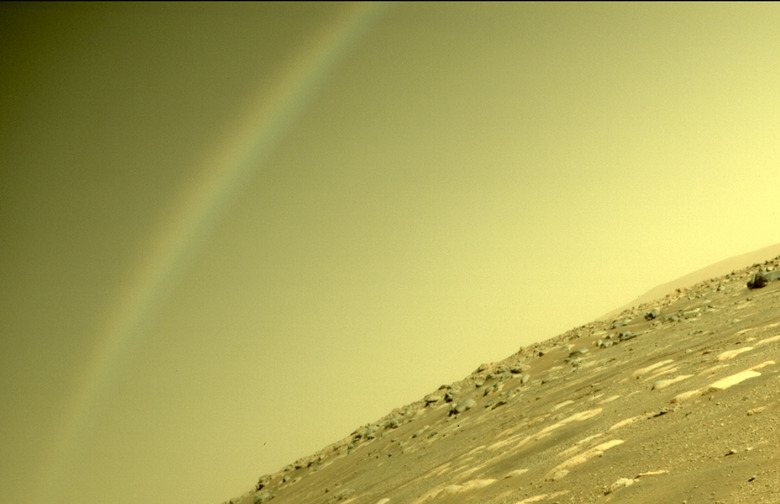NASA's Perseverance Rover Sends Back Awesome Image Of 'Rainbow' On Mars
Rainbows are one of those things that can get just about anyone to stop and glance toward the sky. They're cool to look at and because they're fleeting, enjoying one while it's there just feels like the right thing to do. In a recent photo published by NASA, it appears as though the space agency's newly-landed Perseverance rover enjoyed a rainbow of its own, but is it really a rainbow or something else entirely?
The photo, which was snapped by the rover's rear left hazard avoidance camera — the rover has several of these so that it knows what is around it and can avoid obstacles if needed — shows what looks a whole lot like a slightly-less-colorful rainbow streaking across the Martian sky. Of course, a rainbow would require a significant amount of water to be floating around in the planet's atmosphere, and since we know that's not the case there has to be some other explanation.
When NASA published the photo it wasn't long before comments about the strange rainbow-like band began popping up on Twitter and elsewhere. It certainly looks like a rainbow, and people that don't necessarily know what the Martian atmosphere lacks (or don't understand how rainbows form in the first place) may have assumed that's exactly what it was. However, there are a few other explanations.
A rainbow forms when light from the Sun catches water droplets in the atmosphere at just the right angle, splitting the white light into its various hues which are directed back toward the ground. You have to be in the right place to see a rainbow, and the same is likely true of this Mars light band, but what is it actually made of?
Well, right now there are two theories. One is that the light is actually reflecting off of tiny dust particles in the atmosphere. Mars doesn't have a lot of water floating around but it sure does have plenty of dust. It's possible that if dust is catching the light in the right way it could produce a band as we see here.
The other possibility is that the reflection is coming from water, but not in its liquid form. Mars is very cold and any water in the atmosphere would be in the form of ice particles. Scientists have proposed this as an explanation for these kinds of sightings — this isn't the first time it's been spotted on Mars — but it's incredibly difficult to confirm any of it with just a handful of sightings and relatively low-resolution photos.
In the future, when mankind finally makes crewed trips to the Red Planet, we might finally get a concrete explanation for what we're seeing in these images, but until then we'll just have to guess.
